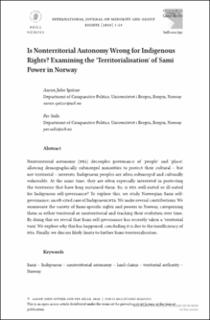Is Nonterritorial Autonomy Wrong for Indigenous Rights? Examining the ‘Territorialisation’ of Sami Power in Norway
Journal article, Peer reviewed
Published version

Åpne
Permanent lenke
https://hdl.handle.net/11250/2758190Utgivelsesdato
2020Metadata
Vis full innførselSamlinger
Originalversjon
International Journal on Minority and Group Rights. 2020, 1–24. https://doi.org/10.1163/15718115-BJA10009Sammendrag
Nonterritorial autonomy (nta) decouples governance of ‘people’ and ‘place’, allowing demographically submerged minorities to protect their cultural – but not territorial – interests. Indigenous peoples are often submerged and culturally vulnerable. At the same time, they are often especially interested in protecting the territories that have long sustained them. So, is nta well-suited or ill-suited for Indigenous self-governance? To explore this, we study Norwegian Sami self-governance, an oft-cited case of Indigenous nta. We make several contributions. We enumerate the variety of Sami-specific rights and powers in Norway, categorising them as either territorial or nonterritorial and tracking their evolution over time. By doing this we reveal that Sami self-governance has recently taken a ‘territorial turn’. We explore why this has happened, concluding it is due to the insufficiency of nta. Finally, we discuss likely limits to further Sami territorialisation.
